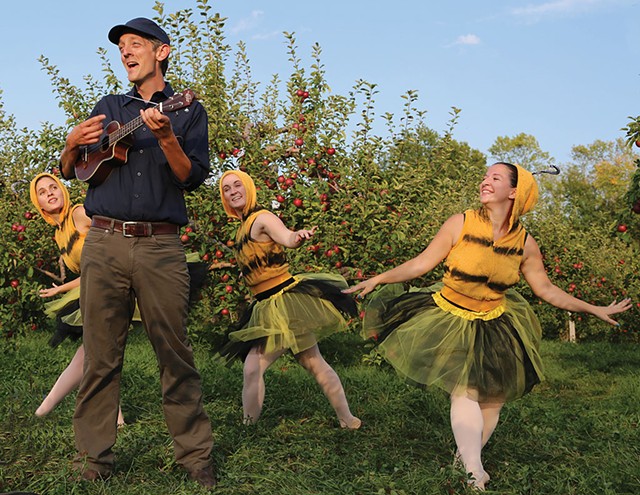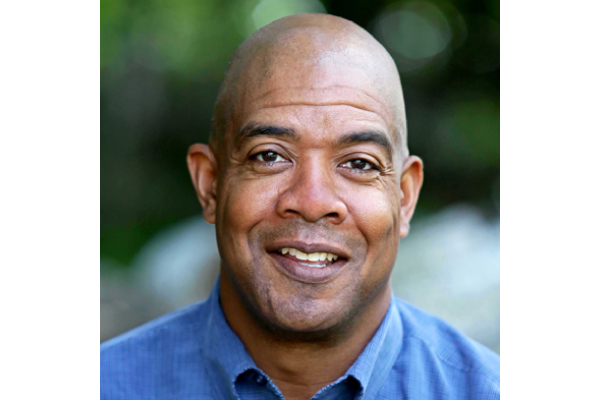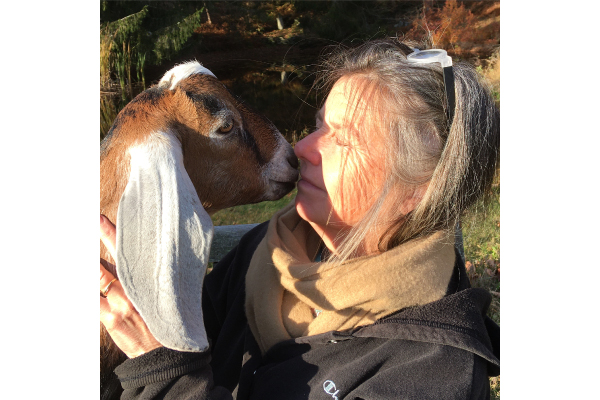By KEN PICARD | COURTESY OF VERMONT PBS
The scene opens with the sun rising over the Green Mountains on a typical Vermont family farm, where brown dairy cows graze and happy pigs munch apples and get their bellies rubbed. Amid vegetable rows strolls a singing farmer carrying a leather satchel and wearing a trilby hat and navy shirt with a yellow heart stitched onto the chest pocket.
The farmer, Mister Chris, enters a barn — actually a TV studio set at Vermont PBS headquarters in Colchester. There he swaps his outdoor hat for an indoor cap, finishes his song and welcomes his audience.
“Hi, friends. How do you feel today? I feel glad to be together on this fall day in the barn studio. I feel comfortable here. I feel excited to dance,” he says, giving a quick pirouette and a warm smile. “I feel confident to sing. And I feel brave to learn new things. Do you like to learn new things?”
Thin, blue-eyed and elf-like, Mister Chris pulls an apple from his satchel. He explains that he picked it from a tree his grandmother planted many years ago, when he was “just a little, little kiddo. And now it’s a big, big tree, just like you’ll be big one day.”
What follows is the 35-minute pilot episode of “Mister Chris and Friends,” a new locally produced children’s television program from Vermont PBS. The show, which launches its first season of six episodes on November 21, uses live music, movement and “everyday adventures” around Vermont to explore science, nature, and emotional and social development. It’s designed primarily for preschoolers.
In an age when much of children’s media is loud, frenetic and hyperstimulating, and contains peril and violent themes, “Mister Chris and Friends” is almost revolutionary in its gentle approach and leisurely pace. It’s like the slow-food movement of children’s programming, and its values are evident in the show’s opening song, “Listening Is Giving.”
“It’s our theme song as well as our guiding theme that we’re trying to express and actually live by,” explained Chris Dorman, the show’s creator, who also portrays its titular character and writes and performs most of the music. “We feel that it’s a true gift to be listened to, and there are many different ways to listen. So we sing that, and we portray that throughout the show.”
“Mister Chris and Friends” got its start on New Year’s Eve 2015, when Dorman, a professional musician and educator, performed a concert at First Night Burlington. After the show, a Vermont PBS staffer approached him to ask if he’d ever considered doing children’s television.
He had. In fact, Dorman had a notebook full of ideas he’d jotted down years earlier. Dorman lives on Bread & Butter Farm in Shelburne, which he and his wife, Corie Pierce, founded nine years ago after moving to Vermont from Michigan. Their son, Henry, was then 2 years old. In 2012, Dorman started a children’s music and movement class on the farm called Music for Sprouts, which inspired much of “Mister Chris and Friends.”
“If I was going to be in the TV show,” explained the 35-year-old father of two, “I just wanted to be as close to the actual character as I am in real life, which is a music and movement teacher who lives on a farm and who believes that the music can really be inspired by our everyday adventures.”
After pitching the concept to Vermont PBS, Dorman launched a successful Kickstarter campaign that raised more than $29,000 to produce the pilot. The idea, he explained, was to demonstrate that Vermonters were interested in and would financially support a locally produced children’s program.
Vermont PBS has a long history of local programming, noted Holt Albee, the show’s producer and director. But as Albee pointed out, a locally produced children’s program is “definitely out of the ordinary, not just for our station but for all member stations across the nation.”
“Mister Chris and Friends,” he explained, follows a traditional three-act structure. “In each episode, Mister Chris makes a wish to learn something new and goes on a fun adventure of discovery and learning. Along the way, he meets new friends, interviews inquisitive kids and celebrates with a big, big concert.”
The show’s target demographic is kids ages 3 to 6. But as Dorman noted, “If we meet them where they are in a way that deeply respects them, we won’t just reach them. We’ll also reach kiddos who are younger, who are more sensitive and who are older … [in a way that] leaves them feeling respected and listened to.”
Each show includes familiar elements at the beginning and end and introduces new adventures and characters along the way. In the pilot, viewers meet the Wishing Well character, whom Dorman called “a symbol of our imagination if we’ve got a question or a wish or a wonder.”
And that heart stitched onto Mister Chris’ shirt pocket? Another visual metaphor, he explained.
“The Heart Pocket is like wearing our heart on our sleeve, a symbol of the vulnerability of expressing emotion,” he said. “But it’s also a place to hold things close to our hearts.”
Longtime Vermonters will recognize many of the locations where the show was filmed, including Shelburne Orchards, Mount Philo in Charlotte, the Vermont Institute of Natural Science in Quechee and the ECHO Leahy Center for Lake Champlain in Burlington.
Each episode takes on a simple theme or lesson, such as how pollinators do their work, how birds fly and how water moves across the landscape. In the process, Mister Chris also tackles different emotions, such as how to cope with the absence of a parent or loved one.
Even before the show aired, news stories were already favorably comparing “Mister Chris and Friends” to Fred Rogers’ iconic PBS series, “Mister Rogers’ Neighborhood.” The similarities are immediately evident, from Dorman’s gentle nature and singsong voice to his literal tip of the hat to Mister Rogers at the start of each episode: By switching hats, Dorman honors Rogers’ signature practice of removing his jacket and shoes and donning a cardigan and sneakers.
But the parallels run deeper than mere wardrobe changes. As author Maxwell King explains in his new book The Good Neighbor: The Life and Work of Fred Rogers, Rogers’ placid nature belied the intense care and scrutiny he put into choosing every word and song on the show. Rogers’ on-air manner of speaking to children with kindness, respect and humility, King notes, amounted to a distinct language that his writers referred to as “Freddish.”
Those who work on “Mister Chris and Friends” see many of those same qualities in Dorman.
“When Mister Chris walks into the barn studio and asks viewers, ‘How do you feel today?’ that’s not just a catchphrase. That’s genuinely who Chris is, in every aspect of the show,” Albee said. From the dialogue to the arc of the story to the musical score, “He’s always thinking about the most sensitive kiddos. I’m just in awe of all he’s able to juggle in his head.”
Early in the show’s development, Vermont PBS brought in Heather Duhamel, an early childhood education consultant from St. Albans, to advise on the scripts. But as Duhamel noted in a recent interview, it was often Dorman who’d stop production to question whether a particular scene or line of dialogue was fully meeting the needs of every viewer.
She recalled one project in which the team was creating one of the supplemental activity plans that accompanies each episode. Dorman, she said, noticed that the activity plan included physical movements that not all kids could perform.
So the team reached out to the University of Vermont Center on Disability and Community Inclusion to consult on adding more inclusive language. From then on, Duhamel said, the center worked on all of the activity plans to ensure more sensitivity to viewers’ needs and abilities. It addressed such issues as neurodiversity, physical and developmental disabilities, literacy, and English-language proficiency.
As Duhamel put it, “With Chris’ encouragement, we’ve slowed things down and have gone through so many channels of support in the community to make sure that they’re reaching all learners” — traits that she, too, likened to those of Rogers.
How does Dorman feel about such comparisons?
“I feel honored,” he said. “At the same time, I feel as if it would not be very Mister Rogers to feel as though we have to fill those sneakers. He said so many times that he likes us just the way we are.”
“I wish that Mister Rogers was not the only available comparison when a guy like Chris comes along who also happens to be deeply respectful of young children,” said Mark Sustic, a musician and early education professional whom Dorman described as his mentor. (Though Sustic appears in one episode, he has no formal role in its production.) “Chris’ contribution and example are important for all of us,” he said, “especially all the young children and families he inspires.”
Evidently, there’s a real yearning for children’s television that slows things down and speaks to, as Dorman put it, “the most sensitive ears in the room.” When Vermont PBS posted its first episode of “Mister Chris and Friends” online, it was viewed in 50 states and provinces across North America.
Despite its initial popularity, however, Dorman said he’s not eager to see the show expand nationally, at least not yet. Like all parents, he said, he doesn’t want his “baby” to grow up too quickly.
“I consider ourselves to be children in this process,” he said. “My hope is that this first season will reach children genuinely and that it’ll be the first of many, and we’ll see an evolution of this project as the years go on and as we learn, too.”
How very Freddish of him.
A version of this article first appeared on sevendaysvt.com and in Seven Days newspaper, a Burlington-based newsweekly published on Wednesdays and distributed for free at more than 1,000 locations in northern and central Vt. and Plattsburgh, N.Y.




